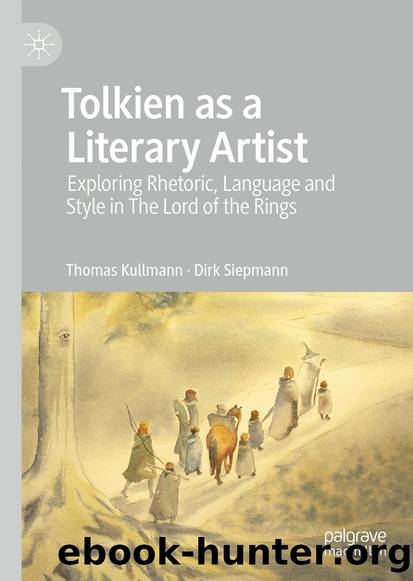Tolkien As a Literary Artist by Thomas Kullmann;Dirk Siepmann; & Dirk Siepmann

Author:Thomas Kullmann;Dirk Siepmann; & Dirk Siepmann
Language: eng
Format: epub
ISBN: 9783030692995
Publisher: Springer Nature
telling stories,
reciting poetry.
In all of these instances, Tolkien follows literary practices which date back to periods preceding the eighteenth century. The present study aims at examining Tolkienâs use of these three categories of text and identifying specific pre-texts and narrative traditions. A further step will then take us to the question how the various literary traditions connect and interact within Tolkienâs overall design.
In the Iliad , speeches form the major part of the direct speech passages: the Greek and Trojan heroes, as well as the gods, meet in councils and engage in debates on what to do in a particular situation. Participants make speeches to convince one another of their points of view. The presuppositions are that the debate is open-ended and that participants can freely express their opinion. In the course of the centuries following the composition of the Homeric epics, the ancient Greeks would define, codify and teach rhetoric, the art of making speeches for purposes of persuasion.1 Rhetoric was commonly understood as the âart of persuasionâ by means of speeches, and rhetorical handbooks regularly distinguish between three main types of speech: deliberative, judicial and epideictic; that is, speeches delivered in the Assembly, in the courts and at public festivals.2 There are no judicial speeches in The Lord of the Rings, but deliberative speeches are quite significant, while some other speeches can be classified as epideictic:As in the Homeric epics there are councils in The Lord of the Rings, in which all the participants can proffer advice and make suggestions. The major site for deliberative speeches made in council is, of course, the Council of Elrond (chapter II, 2, 239â271). Some of the speeches made there serve to inform the council of events which happened in the past, and these will be discussed in the subsequent chapter on stories. Speeches made with the intent to persuade, however, include Elrondâs review of the situation (265), Glorfindel and Galdorâs advice against entrusting the Ring to Tom Bombadil (266â267), Boromirâs proposal to make use of the Ring (267), Elrondâs advice against it (267) and Gandalfâs argument defending the âfollyâ of seeking out the âFireâ in which the Ring was created (269). Other council speeches are Gandalfâs advice as to the Companyâs choice of road (296), Samâs explanation of the absent Frodoâs state of mind and behaviour, provided to the Company (403), and the speeches made by Gandalf, Prince Imrahil and Aragorn at a âcouncil of warâ held at Minas Tirith (878â881).
Download
This site does not store any files on its server. We only index and link to content provided by other sites. Please contact the content providers to delete copyright contents if any and email us, we'll remove relevant links or contents immediately.
4 3 2 1: A Novel by Paul Auster(11776)
The handmaid's tale by Margaret Atwood(7441)
Giovanni's Room by James Baldwin(6800)
Asking the Right Questions: A Guide to Critical Thinking by M. Neil Browne & Stuart M. Keeley(5352)
Big Magic: Creative Living Beyond Fear by Elizabeth Gilbert(5347)
Ego Is the Enemy by Ryan Holiday(4946)
On Writing A Memoir of the Craft by Stephen King(4658)
The Body: A Guide for Occupants by Bill Bryson(4577)
Ken Follett - World without end by Ken Follett(4440)
Bluets by Maggie Nelson(4256)
Adulting by Kelly Williams Brown(4230)
Eat That Frog! by Brian Tracy(4147)
Guilty Pleasures by Laurell K Hamilton(4112)
White Noise - A Novel by Don DeLillo(3825)
The Poetry of Pablo Neruda by Pablo Neruda(3812)
Fingerprints of the Gods by Graham Hancock(3731)
Alive: The Story of the Andes Survivors by Piers Paul Read(3724)
The Book of Joy by Dalai Lama(3688)
The Bookshop by Penelope Fitzgerald(3615)
